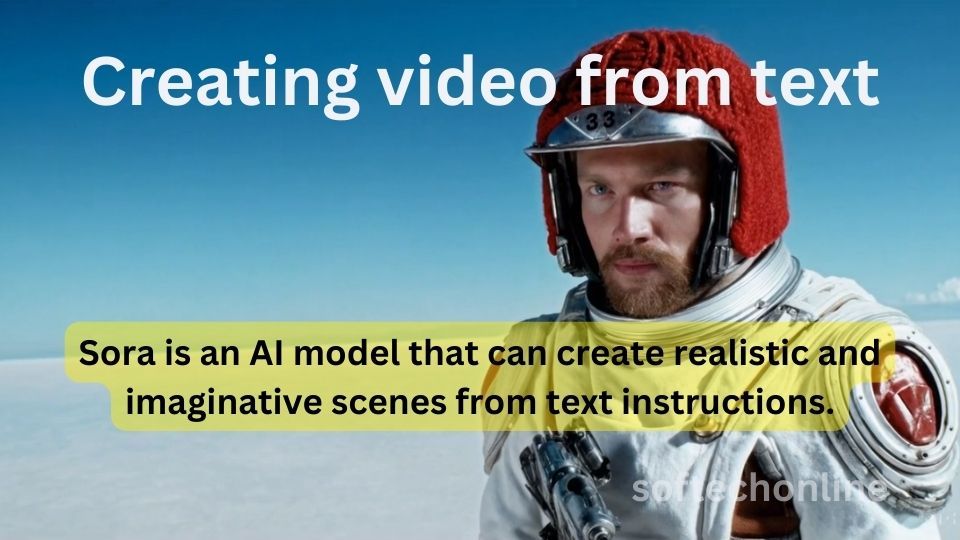The world of content creation is on the cusp of a revolution. OpenAI, a leading research lab in artificial intelligence, has unveiled “Sora” (Sora Text to Video), a groundbreaking text-to-video model capable of generating high-fidelity videos from mere textual descriptions. This innovation has the potential to be a game-changer for the design and videography industry, offering a new level of efficiency, accessibility, and creative freedom.
How Does Sora Text to Video Work?
Imagine describing a scene: “A stylish woman walks down a Tokyo street filled with warm glowing neon and animated city signage. She wears a black leather jacket, a long red dress, and black boots, and carries a black purse. She wears sunglasses and red lipstick. She walks confidently and casually. The street is damp and reflective, creating a mirror effect of the colorful lights. Many pedestrians walk about, eventually generating the above realistic video.
A Boon for Design and Videography:
The implications for design and videography are vast. Here’s how Sora can revolutionize these fields:
- Rapid Prototyping: Imagine instantly generating video mockups for design concepts, storyboards for film pitches, or product demos. Sora allows rapid visualization of ideas, saving time and resources during the early stages of creative projects.
- Increased Accessibility: Professional videography equipment and skills are often out of reach for many. Sora empowers anyone with a creative vision to generate videos, democratizing the process and fostering a new wave of content creators.
- Enhanced Storytelling: Storytellers can use Sora to create dynamic backgrounds, transitions, and even generate visuals based on character descriptions, bringing narratives to life in a more immersive way.
- Personalized Content: Imagine creating explainer videos or marketing materials tailored to specific demographics or regions. Sora’s ability to generate videos based on text descriptions opens doors for personalized content creation.
Beyond the Hype: Challenges and Considerations
While Sora represents a significant leap forward, there are challenges to consider:
- Fine-tuning Control: Currently, achieving precise control over every aspect of the generated video might be difficult. Designers and videographers may need to adapt their workflows to work within Sora’s capabilities.
- Ethical Considerations: AI-generated content raises ethical concerns, particularly regarding potential misuse for creating deepfakes or spreading misinformation. Addressing these issues is crucial for responsible development and deployment of such technology.
- Artistic Expression: Will AI eventually replace human creativity? While Sora offers a powerful tool, the human touch will still be vital for artistic direction, narrative development, and the overall emotional impact of a video.
The Future of Video Creation: A Collaborative Approach
Sora marks the beginning of a new era in video creation. It’s not about replacing designers and videographers, but rather augmenting their capabilities. The future lies in a collaborative approach, where AI handles the heavy lifting of generating visuals based on human-crafted descriptions, freeing up creative professionals to focus on story, concept, and artistic refinement.
As Sora and similar technologies evolve, we can expect a surge in innovative video content across various industries. The possibilities are truly limitless, and the design and videography landscape will never be the same.
Sora is now accessible to red teamers for evaluating potential risks and harms in critical areas. Additionally, access is being extended to a select group of visual artists, designers, and filmmakers to gather valuable feedback on refining the model for optimal support to creative professionals. OpenAI is proactively sharing their research progress at an early stage, engaging with individuals beyond their organization, and offering the public insight into the evolving landscape of AI capabilities
Read In-depth details from official page
Frequently Asked Questions:
1. What kind of videos can Sora generate?
Sora can generate a wide range of video styles, from realistic to cartoonish, depending on the text description provided. It can create explainer videos, product demonstrations, storyboards, concept showcases, and more.
2. Does Sora require any coding knowledge to use?
No, Sora is designed to be user-friendly and doesn’t require coding expertise. The interface will likely involve text input fields where users can describe the desired video content.
3. Will Sora replace videographers and video editors?
Not necessarily. Sora is more likely to be a collaborative tool. Videographers can use it for rapid prototyping, generating backgrounds, or creating base visuals that can be further refined with editing software.
4. How will copyright work with AI-generated videos?
The legal implications of copyright for AI-generated content are still under discussion. It’s important to ensure that the text descriptions used for generating videos don’t infringe on existing copyrights.
5. How can I access Sora?
Sora is currently under development and not yet available for public use. OpenAI might release a limited access program or a paid service model in the future.
6. What are the ethical concerns surrounding Sora?
As with any powerful AI tool, there are concerns about misuse. Sora’s ability to generate realistic videos could be exploited for creating deepfakes or spreading misinformation. OpenAI will need to implement safeguards and ethical guidelines for responsible use.
7. Will AI ever be able to create truly original and creative video content?
While AI can generate impressive visuals, true creative vision and storytelling still require human input. Sora can be a powerful tool for realizing those visions, but originality and emotional impact will likely remain the domain of human creators.
Read more tech stuff on https://softechonline.in/
